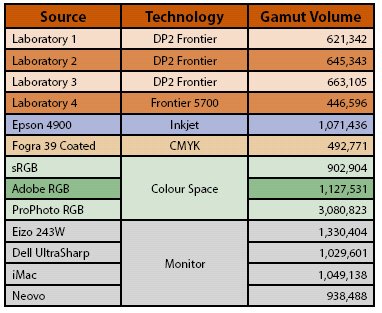articles/Qualifications/laf-page6
Fellowship - Associateship - Licentiateship Technical Quality Requirements - part 6 of 1 2 3 4 5 6 7 8 9 10 11 12 13 14
by Tom Lee Published 01/04/2014

The gamut sizes are frequently bandied about by proponents of one work flow or another. The facts speak for themselves and the size of the gamut influences the saturation (in particular) of colours out near its boundary. Thus with our normal printer-test patches it is the so-called HiGAM set which is the most degraded by a smaller gamut. A shift from say Adobe RGB to sRGB may look OK, especially as the neutrality of the low saturation tones is preserved, but the problem is compounded by the difference in gamut shapes which causes additional loss of accuracy.
Thus a straight change from Adobe RGB to sRGB will mostly influence the greens and cyans, an area in which discrimination is reduced anyway. However, if you throw in another gamut shift by printing to a silver halide printer then the sRGB damages the cyans and greens, followed by a restricted red range of the printer gamut damaging the reds. This assumes that you have to use sRGB for the silver halide system which depends on the colour management policy of the printer.

This complex chart needs some explanation! It is a Lab plot so all the colours are arranged around the chart. The large coloured squares indicate the positions of the HiGAM patches from the chart below the graph. The blue diamonds indicate where an accurate rendering of the patch would be in the chart. The patches have then been translated into sRGB and the arrows indicate the direction they shift, along with the size of the error introduced by doing so. Note that all the colours are shifted towards the middle of the chart representing a drop in saturation. Note also that the red, magenta, plum, and magenta-blue patches only move by a small amount in comparison to some of the others and that the 'cyans' have the largest shift. For reference, a well-profiled Epson HDR ink set can place the HiGAM colours in a print without any shift at all. In the chart on the next page the effect of applying both an sRGB gamut shift and a silver halide printer shift is shown.
Hence the worst case scenario is one which we have analysed with real prints, ie we took the HiGAM patch set, converted it to sRGB and then printed it through a Fuji Frontier 5700. This resulted in an average error of 5.34ΔE00 across all 216 patches (which includes predominantly in-gamut colours) but a HiGAM patch set error of 11.33ΔE00 within which a maximum error of 17.38ΔE00 (on the orange) and with nine out of 13 being more than 10ΔE00. The only error which was small in the entire set was the true blue (at just 0.68ΔE00). For reference, an error of 1 is detectable by eye under ideal conditions, we average around 3.0 for well-profiled inkjet printers.
Please Note:
There is more than one page for this Article.
You are currently on page 6
- Fellowship - Associateship - Licentiateship Technical Quality Requirements page 1
- Fellowship - Associateship - Licentiateship Technical Quality Requirements page 2
- Fellowship - Associateship - Licentiateship Technical Quality Requirements page 3
- Fellowship - Associateship - Licentiateship Technical Quality Requirements page 4
- Fellowship - Associateship - Licentiateship Technical Quality Requirements page 5
- Fellowship - Associateship - Licentiateship Technical Quality Requirements page 6
- Fellowship - Associateship - Licentiateship Technical Quality Requirements page 7
- Fellowship - Associateship - Licentiateship Technical Quality Requirements page 8
- Fellowship - Associateship - Licentiateship Technical Quality Requirements page 9
- Fellowship - Associateship - Licentiateship Technical Quality Requirements page 10
- Fellowship - Associateship - Licentiateship Technical Quality Requirements page 11
- Fellowship - Associateship - Licentiateship Technical Quality Requirements page 12
- Fellowship - Associateship - Licentiateship Technical Quality Requirements page 13
- Fellowship - Associateship - Licentiateship Technical Quality Requirements page 14
1st Published 01/04/2014
last update 09/12/2022 14:55:37
More Qualifications Articles
There are 0 days to get ready for The Society of Photographers Convention and Trade Show at The Novotel London West, Hammersmith ...
which starts on Wednesday 15th January 2025





